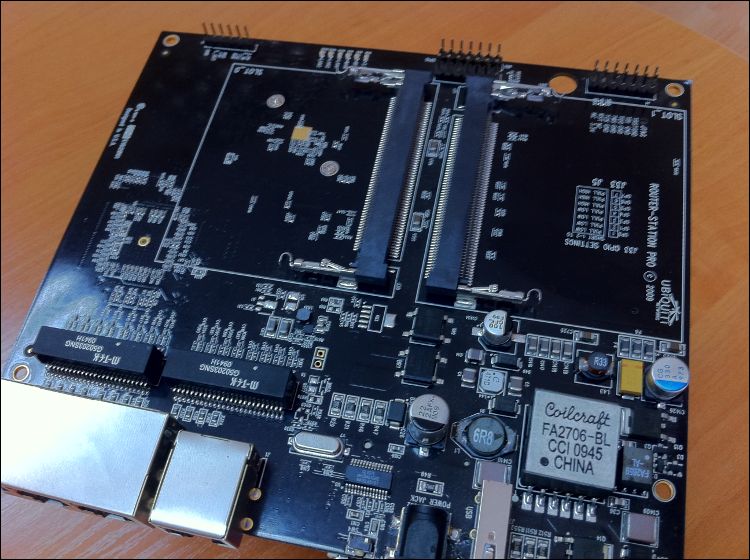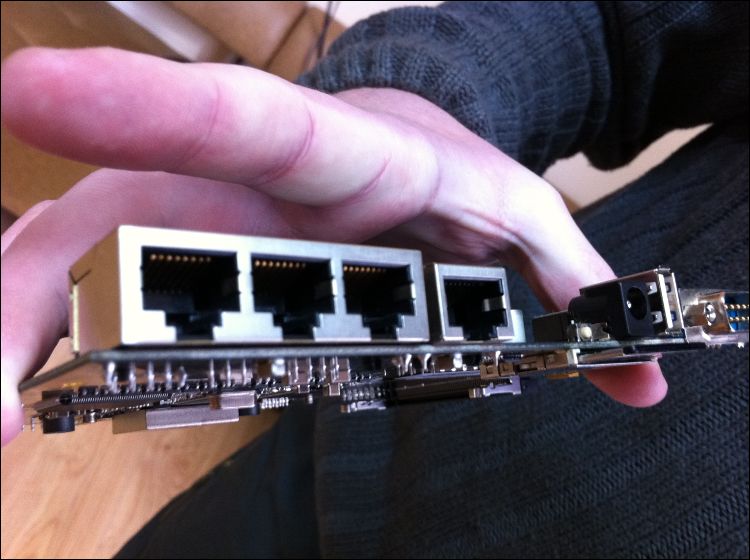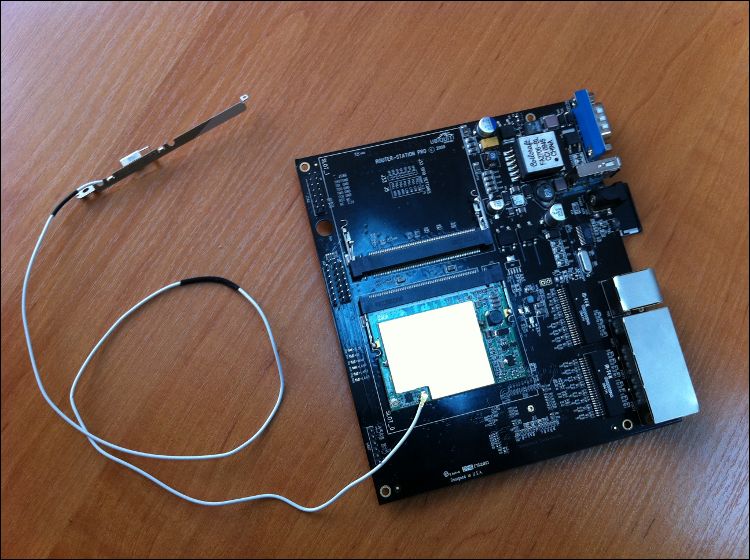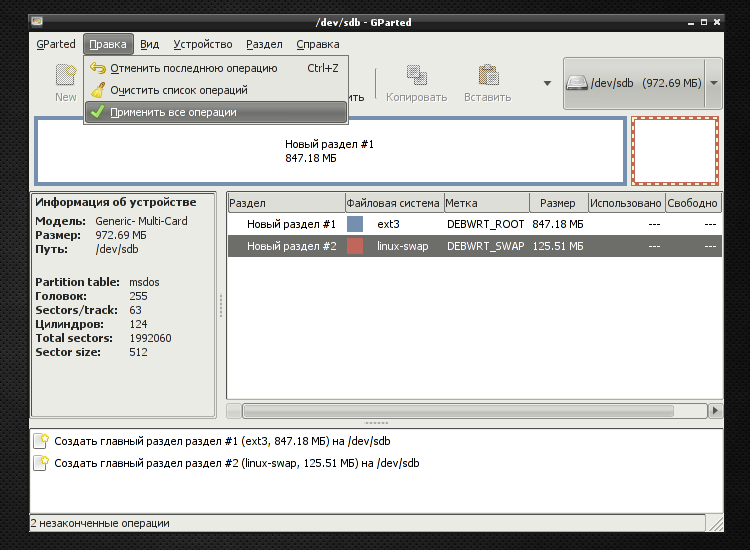Ubiquity RouterStation Pro: a small overview and installation of Debian GNU / Linux
 Greetings, habracheloveki.
Greetings, habracheloveki. I bring to your attention a brief overview of one of the Ubiquity devices in the embedded systems line, namely, RouterStation Pro (hereinafter referred to as “rspro”). Comparing with other products on the market, we can say that this is an extremely functional and productive router . The Pro version also has a younger sister, with more modest technical characteristics. But first things first.
Hardware
The products of the RouterStation line itself are interesting to geeks not only for technical goodies: both models took part in the RouterStation UI / Firmware Challenge and were developed jointly with the community. This means that we have the opportunity to install almost any software on the hardware, including the native AirOS, OpenWRT, DD-WRT and even FreeBSD, and for those who do not like to poke around in the console, several teams drew good web mords instead of the default ones.
Let's take a look at the specifications of both devices.

As you can see, the two sisters differ quite seriously: in addition to gigabit ports and twice the amount of memory, the older one has a large number of all kinds of ports. For the tests, I got the older model, we will consider it a little more, and then we will replace the default OpenWRT with Debian GNU / Linux.


To begin with, it immediately catches the eye when unpacking. A device of the embedded systems category has poor equipment: we will not find a power supply for the device in the kit, we will not find a beautiful glossy case, in short, we will not get a device ready for use. RouterStation are not equipped with any wireless module (and their boards support up to three pieces) and do not have a built-in. Thus, for a consumer who decides to apply it, the costs are quite high.
For starters, it would be nice to enable rspro - on the board, unlike the younger version, there is a fairly ordinary DC jack, and the input voltage range is large enough to give us the opportunity to experiment. Ubiquity recommends not bending the stick and using a PSU with a high voltage, arguing for a reduced amperage. In stocks found a power supply from an HP printer at 24 volts. It should be noted that it is still not enough and the problems will come out sooner or later - either with all three wireless modules, or with powerful USB devices like HDD, which I encountered later. Nevertheless, the total consumption of the board itself in idle time is quite small, which allows it to work quite stably.

Do not forget about wireless modules. Ubiquity recommends using your own SuperRange & XtremeRange cards, but we all know that almost any mini-pci cards supported by the kernel (or firmware) will do. These are the good half of all home routers, but can be freely purchased separately. I got a Senao NMP-8602 + card with a / b / g standard and 400 mw power, with an antenna from a laptop.
This does not mean that Ubiquity takes money for air and sells its cards at inflated prices - on the contrary, their models are quite high-quality devices, among which there are high-power cards and rather unique devices, for example, the 900 MHz band.

Debian GNU / Linux
Having assembled our constructor, you can proceed to the most interesting part - firmware. The desired image is offered to us by the DebWRT project , the instructions are quite simple and understandable. However, I will make a digression: all the actions are much easier to carry out, having a working Linux distribution at your disposal.
First of all, you need to download all the files necessary for work. Three of them will be required:
debwrt-firmware-ar71xx-generic-ubnt-rspro-squashfs-factory.bin (1.3mb)
debwrt-modules-ar71xx-generic_UBNTRSPRO-2.6.32.20-angel-2.0-1.tar.gz (4.5mb)
debwrt-rootfs-mips-2.0-1.tar.bz2 (70.2mb) The
links are straightforward, in case the versions change - the download page .
Next, you need to find a suitable drive for kernel modules and rootfs. Everything will suit absolutely - from flash drives and SD cards to hard drives. I found a 1 GB MMC card, and I do not recommend using smaller disks - it will be cramped.
You will need to perform a predefined markup:
- / dev / sdb1 - DEBWRT_ROOT - Linux - ext3 - Rest of available size
- / dev / sdb2 - DEBWRT_SWAP - Linux Swap - 128MB

... and chat fsck not to check our disk yourself:
root:~# tune2fs -c 0 -i 0 /dev/sdb1
tune2fs 1.41.12 (17 May-2010)
Setting maximal mount count to -1
Setting interval between checks to 0 secondsNow mount the ext3 partition and unpack rootfs and modules onto it.
root:~# mkdir /mnt/debwrt
root:~# mount /dev/sdb1 /mnt/debwrt
root:~# cd /mnt/debwrt
root:/mnt/debwrt# tar xvf ~/debwrt-rootfs-mips-2.0-1.tar.bz2
root:/mnt/debwrt# tar zxvf ~/debwrt-modules-ar71xx-generic_UBNTRSPRO-2.6.32.20-angel-2.0-1.tar.gz
root:/mnt/debwrt# cd ~
root:~# umount /mnt/debwrt
Excellent. It remains only to arm with instructions and fill in debwrt-firmware * .bin in rspro with the OpenWRT method - via tftp. It’s easy to do it from any OS, I won’t stop there. I’ll only note a couple of facts:
- tftp must be set against the WAN port, but after the firmware do not rush to switch the patch cord to the LAN - debwrt by default only raises eth0, which is just the WAN port;
- in recovery mode, rspro has the address 192.168.1.20, in normal mode, debwrt is configured to 192.168.1.1.
This completes the installation, you can begin to configure and give free rein to imagination. A small official post-installation guide can be found here .
For a minimal home router, you will need to configure network interfaces, enable dns / dhcp server, enable ipv4 routing in the kernel and write a couple of simple rules in iptables. For the functioning of the wireless access point, hostapd is required , it is preinstalled and has a couple of default configs. In a word, typical Debian, without the traditional OpenWRT's crutches.
The hardware platform is exceptionally productive for devices of this size. Now I have on rspro apache2 + mod_svn, php5, rtorrentbut she still does not die. Judging by the measurements, the device will be able to squeeze about 30-40 MB / s on NAT until the CPU resources run out. Speaking about the expansion options, it is worth mentioning the existing video cards, sata-raid cards, etc., made in the mini-pci form factor and, obviously, compatible with the RouterStation, and more precisely, with the Linux kernel. And if this is true, then the possibilities are truly endless.
Summarizing, I want to say that this was the most positive experience in communicating with network devices of this class. The device is ideal for anyone who is uncomfortable working with OpenWRT or DD-WRT, who does not plan a mezzanine, noisy x86 architecture vacuum cleaner, who needs high network performance or is just tired of a cheap router.
Obviously, the price is also worth mentioning. Younger sister can be found at a price$ 71 , the oldest - from $ 80 , with the case - from $ 110 . When ordering from ebay, you will have to pay a rather large shipping cost, comparable to the premium in local retail stores.
